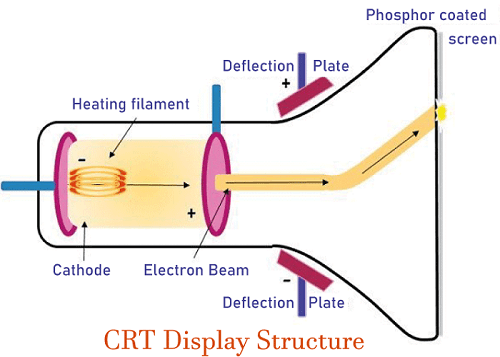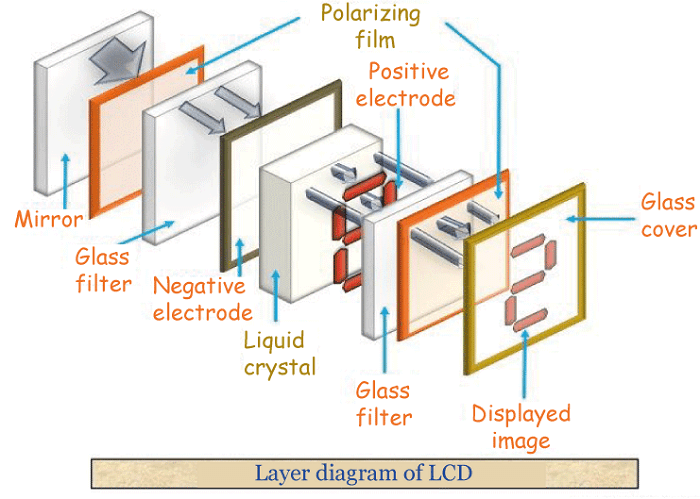Difference between CRT and LCD DisplayBoth CRT and LCD are display devices. CRT displays are old display devices, but LCDs are more recent technology. The main distinction between these displays is in the technology utilized for image formation. The CRT display uses an electron beam to generate a picture, whereas the LCD uses a liquid crystal display to generate an image on the screen. CRT combines the two processes of light generation and modulation, and it is also handled by a single set of components. In contrast, the LCD separates light creation and modulation processes. In this article, you will learn about the difference between CRT and LCDs. But before discussing the differences, you must know about CRT and LCDs with their advantages and disadvantages. What is CRT Display?CRT is an abbreviation for "Cathode Ray Tube". CRT displays to generate an image on the screen by directing a crisp stream of electrons at a phosphor screen in front of the tube. The electron gun, focusing mechanism, and phosphor screen are critical components of a CRT. Phosphor has a valuable light quality in that it may emit light (Fluorescence) continuously for a set period of time when struck by an electron beam. This fluorescence continues to glow even after the beam is removed, a phenomenon known as phosphor persistence. The different types of phosphors and varying time duration may generate various colors of light. 
Electron cannons are mounted on the other side of the screen to emit electrons. The electrons in the electron cannon are managed and driven by concentrating the electrode into the tiny beam at the small spots over the phosphor coating. When the electron beam passes through the deflection plates, it is forced to bend horizontally and vertically in accordance with the horizontal and vertical deflection plates. The horizontal deflection plate's job is to guide the beam from left to right before retracing it from right to left. Furthermore, the vertical plate guides the beam from top to bottom while retracing the scan line from bottom to top. These deflection plates utilize an electrostatic mechanism, whereas magnetic deflection is also utilized in some CRTs. The displayed image is saved in a memory space called a frame buffer. The control circuit plays an important role in providing suitable video signals for the monitor screen. CRT was utilized in older televisions and computer systems. CRT produces low-quality images on the screen and uses a lot of electricity. CRT screens have an extremely short lifespan. Different display technologies are replacing CRTs for a variety of reasons. Advantages and Disadvantages of CRT DisplaysThere are various advantages and disadvantages of CRT displays. Some advantages and disadvantages of CRT displays are as follows: Advantages
Disadvantages
What is LCD Display?LCD is an abbreviation for "Liquid Crystal Displays". It is a flat-panel screen or another electronically modulated optical system that utilizes liquid crystals' light-modulating properties in conjunction with polarizers. The liquid crystals require a backlight or reflector rather than emitting light directly to generate color or monochrome images. LCDs are thinner and more energy efficient. Therefore, they are utilized in various small-sized devices such as mobile phones, laptops, televisions, desktop computer monitors, calculators, etc. LCDs were a significant leap over the technology they replaced, including light-emitting diode (LED) and gas-plasma displays. LCDs allowed displays to be much thinner than CRT technology. LCDs require less electricity than LED and gas-display displays as they function on the regulation of blocking light instead of emitting light. Where an LED absorbs light, the liquid crystals in an LCD utilize a backlight to form an image. LCDs have started to be replaced by new display technologies like OLEDs as they have replaced earlier display technologies. Working of LCD DisplayLCDs operate on the principle that when an electrical current is used to a liquid crystal molecule, the molecule untwists. It causes the angle of light passing via the polarized glass molecules and the angle of the top polarizing filter changes. As a result, some light may flow through the polarized glass via a specific area of the LCD. As a result, that specific area will become darker than others. The LCD functions on the light-blocking principle. While the LCDs are being produced, a mirrored mirror is placed on the back. An electrode plane composed of indium-tin-oxide is placed on top of the device, and a polarized glass with a polarizing film is also placed on the bottom. A common electrode must enclose the entire region of the LCD, and liquid crystal matter must be placed above it. 
After that comes the second glass piece with a rectangle-shaped electrode on the bottom and other polarizing films on top. It should be considered that both components are maintained at the right angles (90 degrees). When no electricity is present, the light goes via the front of the LCD, is reflected by the mirror, and bounced back. When the electrode is linked to a battery, the current generated by the battery causes the liquid crystals between the common-plane electrode and the rectangular electrode to untwist. As a result, the light is stopped from passing. That particular rectangle seems to be empty. Advantages and Disadvantages of LCD DisplaysThere are various advantages and disadvantages of LCDs. Some advantages and disadvantages of LCD are as follows: Advantages
Disadvantages
Key differences between CRT and LCD Displays
There are various key differences between CRT and LCDs. Some of the key differences between the CRTs and LCDs are as follows:
Head-to-head comparison between CRT and LCD DisplaysHere, you will learn head-to-head comparisons between CRT and LCDs. The main differences between CRT and LCDs are as follows:
ConclusionBoth CRT and LCD are fairly different. However, each has advantages and cons. However, CRTs are nearly extinct these days. CRT is an outdated technology with problems such as visual flickering, excessive power consumption, and limited resolution. However, in some regions, these are still in use.LCD is a newer technology that has overcome some restrictions of CRTs. However, the CRT response rate is still better than LCD.
Next TopicDifference between
|
 For Videos Join Our Youtube Channel: Join Now
For Videos Join Our Youtube Channel: Join Now
Feedback
- Send your Feedback to [email protected]
Help Others, Please Share










